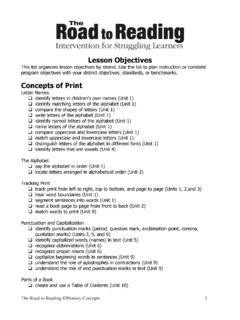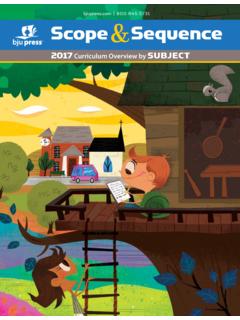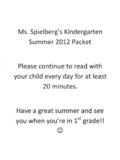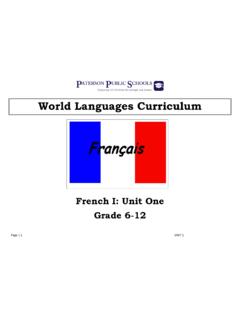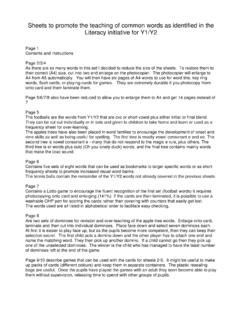Transcription of ABLLS-R and ABLLS Cross Reference - Tracking Sheets
1 ABLLS -R and ABLLS Cross ReferencePage 1 RABLLSS kill AreaTask NameNotesA1A1 ModifiedA2A2 ModifiedA3A3 Look at a non-reinforcing itemModifiedA4A4 Take a common object when offeredModifiedA5n/aApproaches when a response is required for reinforcementA6A5A7n/aResponds for multiple instructorsA8n/aWaits without touching stimuliA9n/aLooks to instructor for instructionA10n/aScans items in array before respondingA11n/aResponds quickly when given an instructionA12A6 Variation in reinforcement (non-edible)A13A7 Intermittent tangible reinforcementA14n/aInstructor interaction reinforcementA15n/aLooks for instructor's change in facial expression and voiceA16A8A17A11A18A9 Seeks approval for task completionA19A10B1B10 Visual PerformancePuzzle with a single-piece type of insertB2B9 Form boxB3B1 Match identical objects to sampleModifiedB4B4 Match objects to pictureB5B2 Match identical pictures to sampleModifiedB6B3 Match pictures to objectsB7n/aFluent matchingB8B5 Sort non-identical itemsModifiedB9B6 Block designs on picture cardModifiedB10B11 Puzzles with multiple connecting pieces in an inset-type frameB11B12 Puzzles with a square-edged border frameB12B7 Block designs from picturesB13B8 Sequence
2 Pattern to match a visual modelB14B13 Puzzles with multiple pieces which must be juxtaposedB15B14 Jigsaw puzzlesB16n/aMatch associated picturesB17n/aSort by functionB18n/aSort by featureB19n/aSort by classB20B15 Delayed replication of a sequenceB21B16 Delayed finding a sampleB22B17 Extend a sequence patternModifiedB23B18B24n/aDependent matching sequenceB25B19B26B20 Picture sequencesB27B21 MazesC1C1 Receptive LanguageResponds to own nameModifiedC2C2 Follow instruction to do an enjoyable action in contextModifiedC3C3 Follow instruction to look at a reinforcing itemModifiedReinforcersTake reinforcer when offeredTake a reinforcer fro two choices of itemsResponds to instructor controlled reinforcersResponds to social reinforcersWaits appropriately if reinforcer delivery is delayedTask completion serves as reinforcerReplicate simple 3-dimensional objectsSerrationABLLS-R and ABLLS Cross ReferencePage 2C4C5 Follow instruction to touch a reinforcing item in various positionsModifiedC5C6 Follow instructions to touch a common item in various positionsModifiedC6C7 Follow instructions to do an enjoyable action out of contextModifiedC7C8 Follow instructions in routine situationsC8C9 ModifiedC9C10 Follow instructions to do a simple motor actionModifiedC10C11 ModifiedC11C12 Follow instructions to select one reinforcing item from an arrayModifiedC12C13 Follow instructions to select one
3 Of two reinforcing itemsModifiedC13C14 Follow instructions to select one of two common objectsC14C15 Select one of two pictures of common itemsC15C17 Touch own body partsC16C23 Select one of six or more objects on a tableModifiedC17C24 ModifiedC18C35C19n/aC20C16 Varied instructions to select using any responseC21C18 Point to body parts on others or picturesC22C19 Touch own pieces of clothingC23n/aTouch parts of itemsC24C40 Select adjectivesC25n/aC26n/aFollows hand signalsC27C27follow an instruction to go to a personC28C28follow an instruction to give an item to a person or place on objectC29C29 Follow an instruction to walk to someone and get a named objectC30C30 Follow an instruction to go to a person and do an actionC31C31 Specific motor responses in receptive tasksC32C32 Demonstrates a specified action with an object when given differentC33n/aMultiple actions with an objectC34C33 Demonstrates a specified pretend actionC35C34 Select one of three pictures representing actionsC36C44 Select associated picturesC37C20 Select by functionModifiedC38C21 Select by featureModifiedC39C22 Select by classModifiedC40C25 Select two items from a larger setModifiedC41C26 Select two items in sequence from a larger setModifiedC42C36 Select community helpersC43C37 Locate objects in larger, complex pictureC44C38 Locate objects from parts of objects in larger.
4 Complex pictureC45C39 Select common environmental soundsC46n/aSelects all examples of an itemC47C41 Selects single items with two specified characteristicsC48C42 Select set of items with a specified characteristicC49C43 Select set of items with two specified characteristicsC50C45 ModifiedC51C47 Receptive prepositionsC52C48 Receptive pronounsC53C50 Follow instructions to give a named, non-reinforcing objectFollow instructions to touch item vs a distractorSelect one of six or more pictures on a tableAcquires new selection skills without intensive trainingFluent receptive discriminationSelect items by following another's gazeFollows a multiple component sequence instructionSelect pictures representing a location or activity in a sceneABLLS-R and ABLLS Cross ReferencePage 3C54C51 Selects pictures representing emotionsC55C46 Selects same and different C56C49 Select non-examplesModifiedC57C52 Selects pictures of social interactionsD1D1 ImitationMotor imitation using objectsD2D2 ModifiedD3D3 Motor imitation of gross motor movements with verbal promptsD4D4 Imitation of leg
5 And foot movementsD5D5 Imitation of arm and hand movementsD6n/aD7n/aVaried imitation instructionD8n/aD9D6 Imitation of head movementsD10D7 Imitation of mouth and tongue movementsD11n/aD12D9 Motor imitation of fine motor movementD13n/aImitation of touching objects in sequenceD14n/aImitation of blowing D15n/aD16n/aD17D8D18n/aD19n/aImitation of a sequence of actions switching with modelD20D10 Imitation of a sequence of actionsModifiedD21n/aImitation of the intensity of an actionD22n/aImitation of the number of repetitions of a motor movementD23n/aSimultaneous imitation of motor movement and a vocalizationD24n/aMotor imitation sequence using multiple objectsD25D11 Imitates motor movement without a direct verbal promptD26D12 Spontaneously imitate the actions of othersD27D13 Delayed imitationE1E1 Vocal ImitationImitates sounds on requestE2n/aImitates sequence of single sounds switching with a modelE3E2E4n/aImitation of multiple separate sound combinationsE5n/aImitation of short and fast vs elongated/slow soundsE6n/aImitation of the number of repetitions of a soundE7n/aImitation of a held sound to a second soundE8n/aConsonant-vowel/vowel-consonan t combinationsE9n/aConsonant-vowel-consona nt-vowelE10n/aConsonant-vowel-consonant combinationsE11E3 Imitate consonant blendsE12E4 Imitation of words on requestE13E5 Imitation of phrases on requestE14E6 Imitation of number sequences on
6 RequestE15n/aImitation of short and fast vs elongated/slow wordsE16n/aImitation of loud vs soft sounds and wordsE17n/aImitation of low vs high sounds and wordsE18n/aRepeat short messages to another personE19E8 Spontaneous imitation of wordsMotor imitation using objects in discriminationImitation discriminating static and kinetic motor movementsImitation of gross motor actions modelled in a mirrorImitation of facial/oral motor movements modelled in a mirrorImitate speed of an ongoing action with objectsImitate speed of a recently modelled action with objectsImitate speed of an action Imitation of touching objects in sequence following a modelImitates initial sounds of wordsABLLS-R and ABLLS Cross ReferencePage 4E20E9 Spontaneous imitation of phrasesF1F1 RequestsF2F2 Multiply controlled requestsF3F3F4F4F5F5 Spontaneous requests with items present (no prompts)ModifiedF6n/aSpontaneous requests with items not present (no prompts)
7 F7n/aRequests with eye contactF8F6 Request others to perform an actionF9F8 Requests missing items needed for a taskF10F9 Requests with head movements or by saying yes/noF11F10 Requests using sentences ModifiedF12F11 Requests helpF13F26 Acquires novel requests without intensive trainingF14F7 Requests attentionF15F12 Request others to remove an item or stop an activityF16F22 Requests using adjectivesF17F23 Requests using prepositionsF18F21 Requests future items or eventsF19F13 Requests information using what ModifiedF20F14 Requests information using where ModifiedF21F15 Requests information using who/whose F22F24 Requests using adverbsModifiedF23F25requests using pronounsF24F16 Requests information using which F25F17 Requests information using when F26F18 Requests information using how F27F19 Requests information using can, do, does, or will F28F20 Requests information using why F29F27 Spontaneous requests G1G1 Label reinforcersG2G2 Labels common objectsG3G3 Labels common people (actual individuals)
8 G4G4 Labels pictures of common itemsG5G9 Labels body partsG6n/aLabels pieces of clothingG7G5 Labels common ongoing actionsG8G6 Labels pictures of common actionsG9n/aG10G7 Acquires novel labels without intensive trainingModifiedG11G8 Labels items using a carrier phraseG12G10 Labels parts or features of objectsModifiedG13G11 Labels adjectivesG14n/aLabel associated picturesG15G12 Labels item when told its functionModifiedG16G13 Labels item when told one of its featuresG17G14 Labels item when told its classG18G22 Two-component labels (nouns) with objectsG19G23 Two-component labels (nouns) with picturesG20G24 Labels two-component with carrier phraseRequests by indicatingRequesting with the reinforcer present and asked what?
9 Requesting when asked what do you want?LabellingFluent labellingABLLS-R and ABLLS Cross ReferencePage 5G21G25 Two-component labels (noun verb)G22G26 Two-component labels (noun adjective)G23G18 Labels by indication yes/noG24G15 Labels function of an itemModifiedG25G16 Labels class of an objectG26n/aDiscrimination of question to label aspects of itemsG27G17 Labels the class of a set of itemsG28G19 Labels features of items which are missing or incorrectG29G20 Labels exclusion from a category (negation)ModifiedG30G21 Identifies obvious problemsG31G27 Labels community helpersG32n/aLabels items at a distance when others point to itG33G28 Labels common environmental soundsG34G29G35G30 Labels prepositionsG36G31 Uses carrier phrases when using prepositionsG37G32 Labels pronounsG38G33 Uses carrier phrases when using pronounsG39G36 Labels and describes events or items presented in a sceneG40G37naming specified parts of scenesG41G38 Label adverbsG42G39 Labels emotions of othersG43G40 Internal events and emotionsG44G34 Multiple component naming (three component labels)G45G35 Labels (three component +)
10 With carrier phraseG46G41G47G42H1H1 Fill in words from songsH2H2 Fill in blanks regarding fun items and activitiesH3H3H4H4 Animal soundsH5H5 Answer questions regarding personal informationH6H6H7n/aH8H7 Fill in item given functionH9H8 Fill in function given itemH10n/aAnswers



